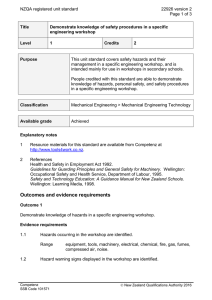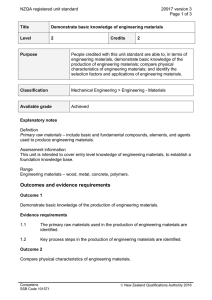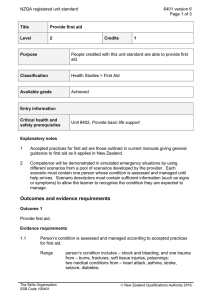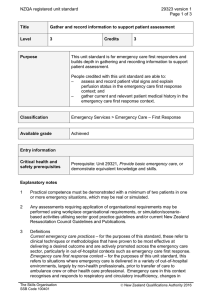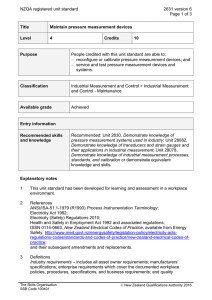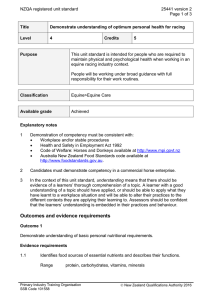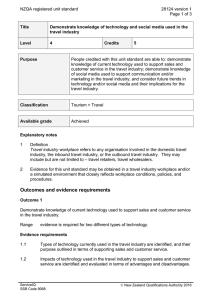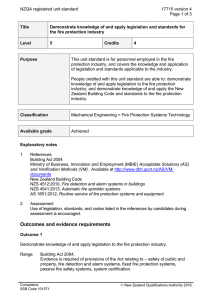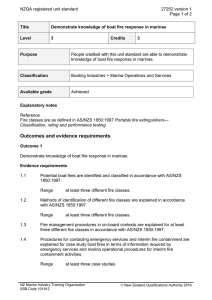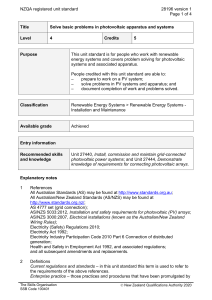NZQA registered unit standard 10785 version 5 Page 1 of 4
advertisement
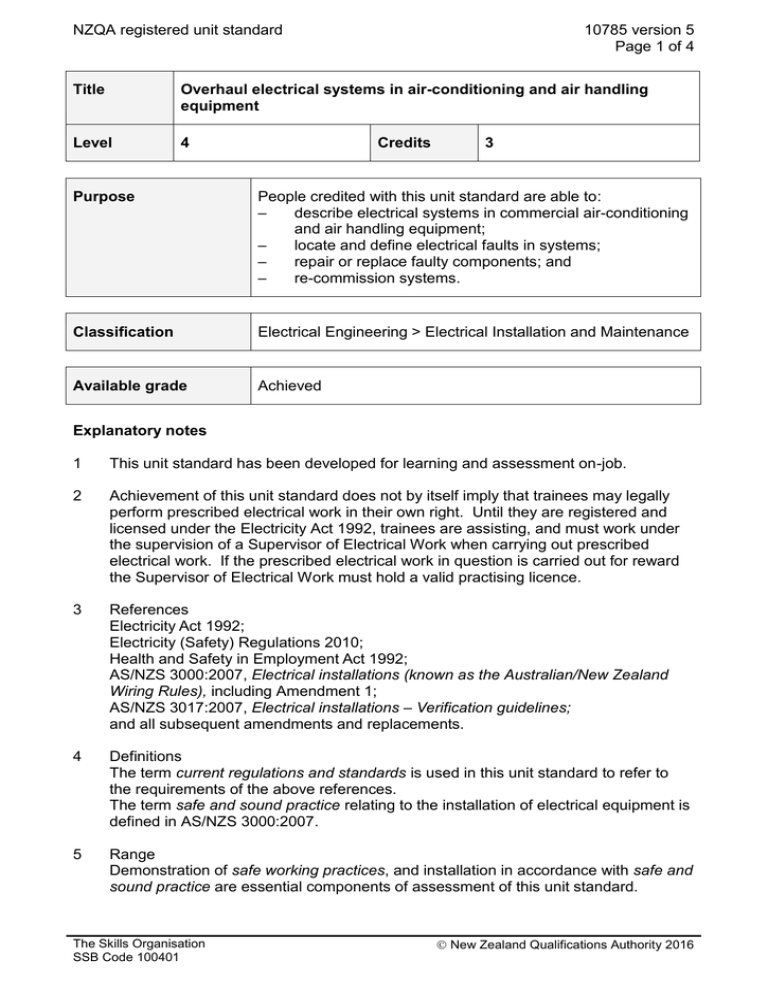
NZQA registered unit standard 10785 version 5 Page 1 of 4 Title Overhaul electrical systems in air-conditioning and air handling equipment Level 4 Credits 3 Purpose People credited with this unit standard are able to: – describe electrical systems in commercial air-conditioning and air handling equipment; – locate and define electrical faults in systems; – repair or replace faulty components; and – re-commission systems. Classification Electrical Engineering > Electrical Installation and Maintenance Available grade Achieved Explanatory notes 1 This unit standard has been developed for learning and assessment on-job. 2 Achievement of this unit standard does not by itself imply that trainees may legally perform prescribed electrical work in their own right. Until they are registered and licensed under the Electricity Act 1992, trainees are assisting, and must work under the supervision of a Supervisor of Electrical Work when carrying out prescribed electrical work. If the prescribed electrical work in question is carried out for reward the Supervisor of Electrical Work must hold a valid practising licence. 3 References Electricity Act 1992; Electricity (Safety) Regulations 2010; Health and Safety in Employment Act 1992; AS/NZS 3000:2007, Electrical installations (known as the Australian/New Zealand Wiring Rules), including Amendment 1; AS/NZS 3017:2007, Electrical installations – Verification guidelines; and all subsequent amendments and replacements. 4 Definitions The term current regulations and standards is used in this unit standard to refer to the requirements of the above references. The term safe and sound practice relating to the installation of electrical equipment is defined in AS/NZS 3000:2007. 5 Range Demonstration of safe working practices, and installation in accordance with safe and sound practice are essential components of assessment of this unit standard. The Skills Organisation SSB Code 100401 New Zealand Qualifications Authority 2016 NZQA registered unit standard 10785 version 5 Page 2 of 4 Outcomes and evidence requirements Outcome 1 Describe electrical systems in commercial air-conditioning and air handling equipment. Evidence requirements 1.1 Electrical systems for commercial air-conditioning and air handling equipment are described in terms of the function they perform. 1.2 Electrical components are identified from pictorial or physical displays, verbal description, and an application requirement. Range thermostat, pressure transducer, pressure switch, compressor, control panel, control unit, light, auxiliary circuitry. Outcome 2 Locate and define electrical faults in systems. Range evidence of at least four faults is required. Evidence requirements 2.1 Electrical components are tested. Range 2.2 visual inspection, tests in accordance with manufacturer's service manual. Faults located during testing are defined and recorded according to supervisor’s or customer’s requirements. Outcome 3 Repair or replace faulty components. Evidence requirements 3.1 Viability of repair or replacement of components is determined in terms of availability and cost of the component, the time available, and supervisor’s or customer's instructions. 3.2 Repair or replacement of components is carried out in accordance with manufacturer's recommendations. 3.3 Replacement wiring is matched to the original to comply with manufacturer’s specifications. Range The Skills Organisation SSB Code 100401 cable type, length, current rating, insulation quality (to suit voltage), operating temperature, rigidity or flexibility. New Zealand Qualifications Authority 2016 NZQA registered unit standard 3.4 10785 version 5 Page 3 of 4 Replaced and/or repaired components are tested in accordance with manufacturer's instructions. Outcome 4 Re-commission systems. Evidence requirements 4.1 Tests and certification are completed in accordance with current regulations and standards. 4.2 Systems are re-commissioned according to manufacturer’s specifications. 4.3 Documentation is completed to industry requirements. Planned review date 31 December 2014 Status information and last date for assessment for superseded versions Process Version Date Last Date for Assessment Registration 1 30 April 1997 31 December 2013 Revision 2 3 April 2001 31 December 2013 Review 3 26 May 2005 N/A Rollover and Revision 4 15 March 2012 N/A Revision 5 15 January 2014 N/A Consent and Moderation Requirements (CMR) reference 0003 This CMR can be accessed at http://www.nzqa.govt.nz/framework/search/index.do. Please note Providers must be granted consent to assess against standards (accredited) by NZQA, before they can report credits from assessment against unit standards or deliver courses of study leading to that assessment. Industry Training Organisations must be granted consent to assess against standards by NZQA before they can register credits from assessment against unit standards. Providers and Industry Training Organisations, which have been granted consent and which are assessing against unit standards must engage with the moderation system that applies to those standards. Requirements for consent to assess and an outline of the moderation system that applies to this standard are outlined in the Consent and Moderation Requirements (CMR). The CMR also includes useful information about special requirements for organisations wishing to develop education and training programmes, such as minimum qualifications for tutors The Skills Organisation SSB Code 100401 New Zealand Qualifications Authority 2016 NZQA registered unit standard 10785 version 5 Page 4 of 4 and assessors, and special resource requirements. Comments on this unit standard Please contact The Skills Organisation reviewcomments@skills.org.nz if you wish to suggest changes to the content of this unit standard. The Skills Organisation SSB Code 100401 New Zealand Qualifications Authority 2016

